“Open the window while I do this”, he says casually.
“Umm… It’s freezing outside! I don’t want the window open”, I answer.
I will come to regret these words for the rest of my life.
Out of his bag, a mysterious vacuum-sealed thing slides onto the cutting board. I watch, standing closely. He takes a knife (Norwegians have cool knives – with bone or wood handles – that make mundane tasks feel kind of Viking-y) and quickly slices open the side of the package.
What happens next can only be described as moments of blind terror and confusion.
The wave of odour that hits me is so thick and heavy, I can feel it falling on to me like a rotting, wet blanket. I stumble backwards in shock and disbelief. This blanket begins to suffocate me, covering my mouth and nose with the most revolting, inexplicable smell I have ever encountered or even imagined possible. At this point, I’m fairly certain death is inevitable. I cannot get to the window and fling it open fast enough.
It’s as though all the fish in the world have simultaneously died and then been left to rot on a hot beach – or, in this case, our apartment.
I’m half hanging out the window, tears dripping from my eyes, contemplating the odds on survival if I were to jump.
“WHAT… <gag>… IS THAT?!”, I cry.
My husband answers…
It’s dinner.
And so it began. My rather rough introduction to Nordic cuisine.
I pride myself on being an adventurous eater and I want my life here to be no different, so I will try almost anything (except “lungemos”). I have eaten bull balls in Spain, snakes in Morocco, crickets in Mexico, and warthog in Africa. Occasionally the choices have been unintentional. At a restaurant in France, it took me until the last bite of my meal to realize that I was eating a pig’s tongue. There is nothing quite like the scorn of a French waiter when a North American is visibly traumatized.
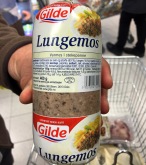
I am also familiar with “preserved foods” and most cultures have some version of their own. In Canada, the indigenous peoples invented “pemmican” – strips of meat dried over a fire or in the sun. In South Africa, where I was born, we eat “biltong” – raw, seasoned beef that is hung to dry. When my Oupie/Grandpa (“farfar” to the Norwegians) came to visit us in Canada, his first order of business was to fashion us a biltong maker out of a cardboard box. And there in the basement hung our little strips of raw meat, drying deliciously. My friends thought it, and in turn I, was weird. That was my first experience of being an outsider in a new land – but certainly not my last. Apparently I am a glutton for expat punishment.
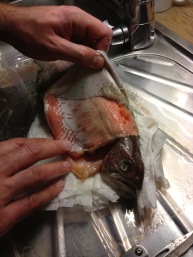
Norwegians have been preparing and eating preserved foods for hundreds of years. This particularly smelly beast, that my husband surprised me with with, was “rakfisk”. The fish (usually trout) is salted, put in a bucket (or a barrel), and then weighed down with a heavy, tight-fitting lid. The salt draws moisture from the fish and creates a brine. So basically, the raw fish shloops around in some fishy liquid in an airtight container for at least 3 months, and up to a year, as it ferments. You must admit, it sounds like a terrible idea. Apparently the first rakfisk on record dates back to 1348. Judging by the smell, I figured the one we were about to eat likely came from that same year. Of all the foods I have eaten (including some cheese that smelled like the underbelly of a tired, sick goat), I have never smelled anything quite like this. And it is eaten raw. My husband assured me that it didn’t taste like it smelled (which is great because I had no interest in knowing what death tastes like) and he figured I would really enjoy it. And the truth is , I did.
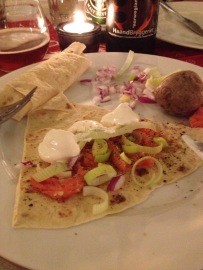 The routine (and many Norwegian meals have well-choreographed routines) is that you take a piece of the fish, lay it on some “lefse” (a thin potato pancake) and then plop on some “rømme” (sour cream – a staple in this land) and some raw onion and leek. Roll ‘er up and you’re good to go. Stink-ito Burrito. These days, some people also serve potatoes on the side (for no particular reason, other than they are good to eat if you can’t handle the raw truth of the rakfisk). Norwegians don’t necessarily buy these types of traditional foods at the grocery store. They sometimes make them from scratch (a true badge of Norwegian honour) or they will swear by a certain local place to buy it. (I don’t know where my husband gets his rakfisk – God help me if I mistakenly open some mystery bucket one day only to discover he’s been making it himself.)
The routine (and many Norwegian meals have well-choreographed routines) is that you take a piece of the fish, lay it on some “lefse” (a thin potato pancake) and then plop on some “rømme” (sour cream – a staple in this land) and some raw onion and leek. Roll ‘er up and you’re good to go. Stink-ito Burrito. These days, some people also serve potatoes on the side (for no particular reason, other than they are good to eat if you can’t handle the raw truth of the rakfisk). Norwegians don’t necessarily buy these types of traditional foods at the grocery store. They sometimes make them from scratch (a true badge of Norwegian honour) or they will swear by a certain local place to buy it. (I don’t know where my husband gets his rakfisk – God help me if I mistakenly open some mystery bucket one day only to discover he’s been making it himself.)
The final essential element, for this and any Norwegian meal, is the drink. In this case there is some beer, but mostly Akevitt, and lots of it. It tastes like fire and it can sure as hell wash down some fermented fish. Norwegians can be quite particular about which beer and/or liquor is served and when. My parents-in-law had Danish akevitt at the cabin last Christmas (“Just for a change!”, they cried) and there was a full scale mutiny by my husband and his brothers. A lengthy and passionate debate of various akevitts – which were then hauled out of the cupboard and lined up on the table for tasting – continued well into the night. (“What’s with this Danish stuff? Here, try the Norwegian one. This one has too much dill! Okay, taste this one. I think this one’s best. Wait, I’m not sure… let me taste it a 3rd time… Jill… are you okay?”)
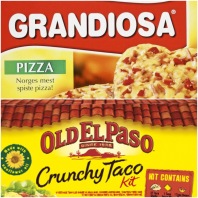 Norwegians take their food and drink seriously, but this doesn’t necessarily mean it has to be fancy or exotic. When discussing Norwegian food, I have to mention the phenomenon of the “Grandiosa” frozen pizza. Love them or hate them, they are a fixture of this culture and over 24 million of them are produced each year. (Keep in mind, the whole of Norway only has a population of 5 million.) I imagine that most cultures have their favourite ready-prepared meal and this is Norway’s. There is also the mystery of the Friday “Old El Paso Taco Kit” dinner. This is truly one of the most surprising and weird things I discovered moving here. I can guarantee you that, as a North American, my people would be hard pressed to imagine Norwegians sitting at home eating frozen pizzas or Old El Paso tacos. It just doesn’t fit the outdoorsy-do it yourself-viking stereotype we want you to uphold!
Norwegians take their food and drink seriously, but this doesn’t necessarily mean it has to be fancy or exotic. When discussing Norwegian food, I have to mention the phenomenon of the “Grandiosa” frozen pizza. Love them or hate them, they are a fixture of this culture and over 24 million of them are produced each year. (Keep in mind, the whole of Norway only has a population of 5 million.) I imagine that most cultures have their favourite ready-prepared meal and this is Norway’s. There is also the mystery of the Friday “Old El Paso Taco Kit” dinner. This is truly one of the most surprising and weird things I discovered moving here. I can guarantee you that, as a North American, my people would be hard pressed to imagine Norwegians sitting at home eating frozen pizzas or Old El Paso tacos. It just doesn’t fit the outdoorsy-do it yourself-viking stereotype we want you to uphold!
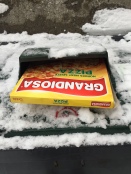
(On a completely unimportant note, personal research has shown that the Grandiosa pizza box is the exact width of Oslo’s paper recycling bins. Norwegian practicality at play, no doubt.)
Frozen pizza and tacos aside, Norwegians know their way around a kitchen. I have never eaten so much good, homemade food in my life. Every Norwegian family (depending what part of the land they are from) have food traditions that tend to run quite deep – often going back many, many generations. For example, if you are from my husband’s home on the west coast, you eat “pinnekjøtt” at Christmas (literally translated as “stick meat”). Like the fish, this lamb is also salted and then left to linger about for several months. In this case, it is hung (in the shed with the bicycles and firewood) to dry. Before cooking, it is soaked in buckets of water for a few days. Norwegian “Torsk” (Cod) is also salted and dried and then soaked in buckets of water before cooking. I think the lesson here is this: if you live in Norway, you better have salt and buckets. And a shed.
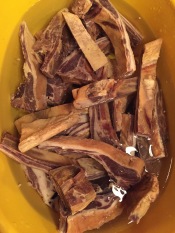
Many food traditions here, and especially holiday ones, could be written about at length. They can seem strange to us foreigners, but I think the Norwegians appreciate it when we at least try. Yes, we may wonder why their favourite cheese (“brunost”) actually takes like caramel candies, or why Rudolf is on the menu , or why we eat sour cream porridge for dinner (“rømmegrøt”), or why the sandwiches so rarely have tops – and have to be eaten with a knife and fork – (I’m looking at you “smørbrød”), but we can try to open our minds and dig in and fit in.

Back to the cabin holiday, I was amazed by the endless flow of delicious food and drink on my first visit. And I was certainly doing my best to dig in and fit in…
So, it’s our first morning there and I am awoken by my husband. I’m not much of a morning person.
“Hey Minky, he says gingerly.
(He calls me “Minky” after the Minke whales synonymous with the Norwegian island where his dad grew up. My pet name is basically “whale” but he assures me Minkes are ‘cute and small’. Right. Also, yes, Norwegians eat whale. It know this is a hard thing to swallow – literally – for my North American friends. There are strict rules for hunting seasons, quotas, equipment and monitoring but it is a controversial topic for those not a part of this culture – and even for some who are.)
“Minkeeeeeey…” (my tiny little 5 ton whale), he whispers, “… everyone is up and waiting for you so we can have breakfast”.
“WHAT? Oh my God.They’ve been WAITING?! Why didn’t you wake me up?!”
Now I am up – faster than is usually recommended after a night of akevitt taste-testing and impromptu solo Celine Dion impersonations. (See my previous cabin tale).
“Can I stay in my pyjamas? Is that okay?” I ask, looking down at my weird, but very comfy, MCHammer-style Indian-cotton pyjama pants, that couldn’t be less Norwegian if they actually tried.
“Sure”, says my husband.
I should have noted at this point that he was showered and fully dressed.
I rush downstairs, wiping the sleep from my eyes, and attempting a makeshift hair brush with my hand. A quick stop in the loo (there is no better invention than a heated bathroom floor. Take note Canada), and then into the room for breakfaaaaa…
I stop suddenly in the doorway.
The entire family is seated at the table. They are dressed in normal clothes like normal people, showered, smiling, and ready to eat. And when I say “normal clothes” in Norway, this means super cool sportswear – which makes them all look like Olympic athletes – and that likely has a little Norwegian flag on it somewhere. To be clear, there aren’t any other Indian-cotton, striped, old and ill-fitting MCHammer pyjama pants in sight.
The breakfast table is laden (LADEN) with the most delicious assortment of things I have ever seen – meats and cheeses and cheeses and meats, and jams and jellies, and fresh-baked breads and crackers and biscuits, and juice and coffee, and eggs (3 ways), and smoked salmon, and other fishy items… as far as my just-opened eyes can see.
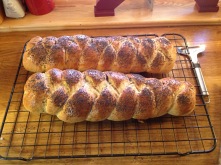
I attempt a hearty “God morn!” (hoping they’ll assume I’ve been up for hours but simply too engrossed in a fascinating b0ok about Norwegian history to come downstairs) and I take a seat. I want to kill my husband for not waking me earlier (but he is too busy eating 1 of the 7 meats on the table to notice). My father-in-law leaps up to pour me coffee (coffee is serious here – Norway is #2 in the top 10 coffee consuming nations – Canada and the US don’t even rank).
My mother-in-law asks if there is anything else I need or want. (I don’t know… maybe different pants and a bra, I think to myself.) Really, my only need is to be more like her but that seems awkward to request. This lady is my hero. Not only is she looking beautiful and impossibly fit in her nordic-wear, but she has also been up for hours – baked bread, walked the dog, got the wood-stove going, gone skiing (“bare en liten tur” she says. “Just a little trip”, which was likely at least 20kms and mostly uphill), started dinner prep, and now laid out this breakfast extravaganza.
I manage to pull myself together enough to take a sip of the delicious dark coffee (they buy milk just for me), and peruse the offerings. I see what looks like some kind of smoked fish on the far side of the table. Why not, I think. When in Norway…
“Kan du sende meg fisken… please?”. “Can you pass me the fish… please”. (I still can’t let go of the English “please“)
What I don’t know at the time, is that this is my father-in-law’s fish. He loves it more than anything. He buys a small amount just for his holiday time at the cabin. And it sits beside his place at the table.
What I also don’t know at the time, is that it’s HIS special fish for the simple reason that the rest of the family think it’s fairly horrible, especially for breakfast.
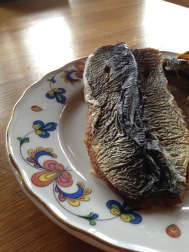
Unaware of all these things, I take some on my plate, flop it on a piece of bread, and eat it.
I notice the family watching me.
“Wow”, says my husband, “I wouldn’t eat that”. His mom and brothers nod in agreement.
“It’s delicious”, I say smugly (and I actually mean it).
My father-in-law smiles broadly.
Now when we go to the cabin, he brings extra of the special fish just for me. It’s OUR fish. I’m part of the very exclusive Norwegian-Cabin-Breakfast-Fish-Club, or as I like to call it the “Norskehyttefrokostfiskeklubb”.
I may survive this land yet.
You make me laugh so much!
Just been shopping for a load of tex-mex goodies for Saturday tea (when in Norway!) and noticed something amusing. Just as in schools there’s “English” and “foreign languages”, in that supermarket there was “Taco” (one whole aisle) and then “ethnic”..! The her.
LikeLike
Thanks! So glad you’re having a laugh 🙂 The “taco” aisle is amazing. How hilariously bizarre.
LikeLiked by 1 person
The Tacos got me in the beginning. Aisles of ready made taco stuff in the supermarkets…the mind boggles.
LikeLike
Yes. I still don’t get it.
LikeLike
I love reading about your experiences in Norway! We only lived there for 1.5 years, but we loved it, & we miss it. It brings back fun memories of our turn at trying not to stick out like a sore thumb 😉
LikeLike
Hi Karla,
Thanks so much and I am so glad you are enjoying my stories! 🙂
LikeLike
I enjoy reading you sooooo much! Like I´m reading a novel 😀 Norwegian cuisine is still ahead of us, as we, at home, practice our own polish cooking 😉 , trying just a bit of typical norwegian products from time to time. Though my husband already had a pleasure of trying the rakfish at julebord (of course he was completely unaware of the challenge!).
LikeLike
Thanks again Anna!
LikeLike